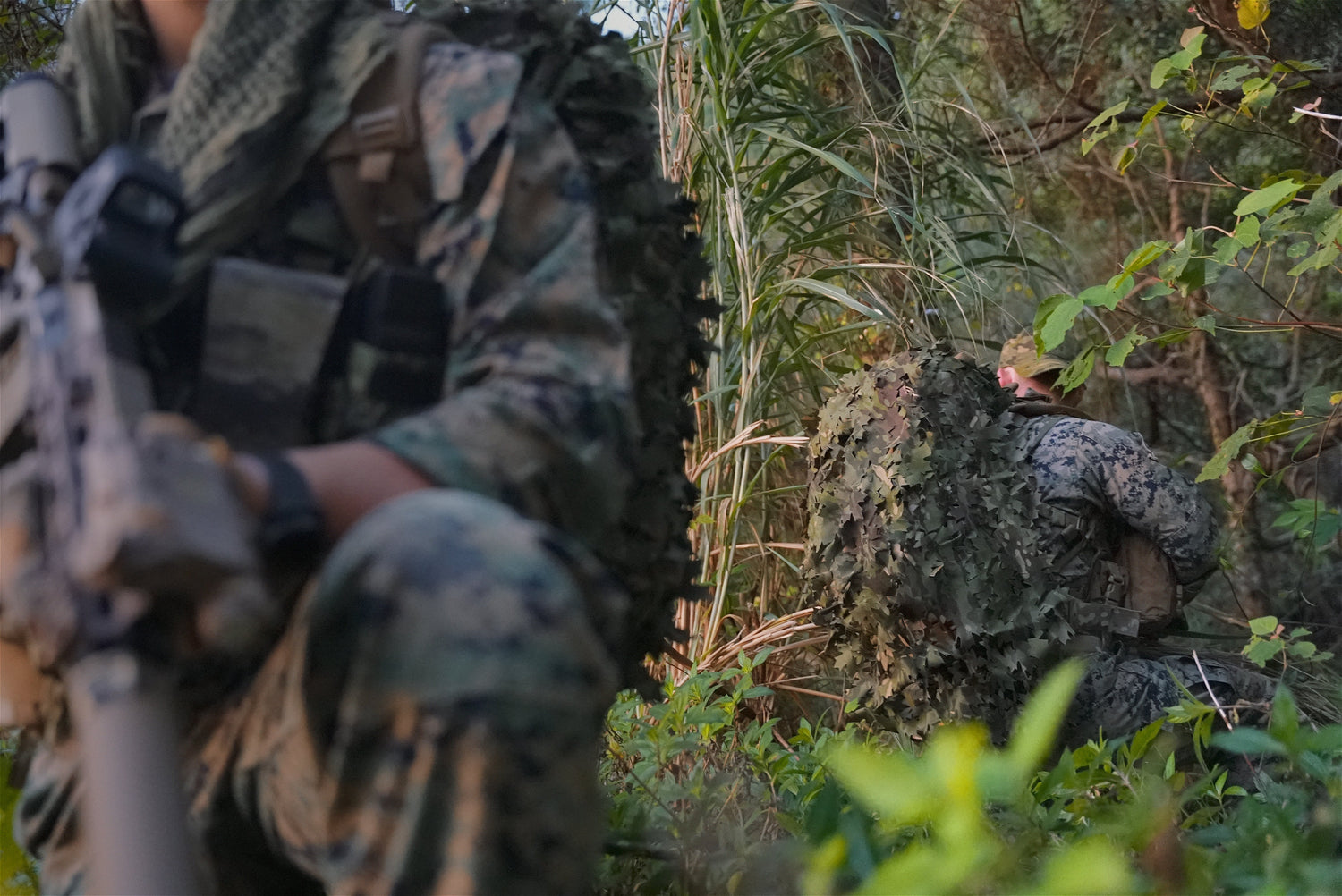Camouflage for Tropical Climates
Camouflage for Tropical terrain hides and reveals in the same breath. Dense leaves. Broken light. Air heavy with moisture that seeps into fabric and circuits alike.
In such conditions, camouflage stops being paint on cloth. It becomes adaptation. Smart materials, nanotech, optical tricks, thermal control. Each piece helps soldiers and vehicles blend, then vanish. The result: new levels of stealth, and new questions for strategy and ethics.
Here’s how the technologies work, and where they lead.
Adaptive Polymers and Nanotechnology: A New Generation | Camouflage for Tropical
Electrochromic polymers: color that obeys
A tiny pulse. The surface shifts. Pattern dissolves; hue slides toward the background. That’s an electrochromic polymer at work.
Inspired by cephalopods and chameleons, these materials change appearance in real time.
Shade to sun. Deep green to damp brown. Jungle light moves quickly; the uniform follows.
Labs now design fabrics that adjust on their own. Less guesswork for the wearer. More time spent on movement, cover, and mission.
Nanostructures: the reactive skin | Camouflage for Tropical
Go smaller and you control light itself. Nanostructures tune reflection and absorption by wavelength. Some trap light; others redirect it.
Result: a surface that confuses both eye and sensor.
Vehicle skins built from hexagonal pixels show what the background shows. Color, brightness, even heat. From a few hundred meters, the shape melts into the scene. An onboard controller handles the mimicry, frame by frame.
Limits in the field | Camouflage for Tropical
The jungle punishes electronics. Heat, water, grit. Everything tries to creep under a seal.
Active displays draw power.
Batteries add weight. Resupply isn’t simple under the canopy.
Durability matters as much as stealth. Flexible, breathable, low-energy systems will win. “Camouflage without draining; endurance without failure.” That’s the target.
Optical Camouflage: Bending Light
Metamaterials and refraction
Metamaterials don’t merely reflect. They steer. By shaping refractive index, they bend rays around an object. To the observer, the background looks continuous; the object fades.
Elegant in theory. Narrow in practice. Visible-band designs often work only for tiny bandwidths or single angles. Losses in metal layers create tell-tale dimming. The “cloak” shows its own shadow.
Transformational optics and projected scenes
Another route uses lenses and active surfaces. Cameras capture the rear view. Micro-projectors paint it on the front. The wearer becomes a moving window.
It works—until nature interferes. One drop, one smear, one misalignment, and the illusion slips. Precision helps, but rain, mud, and foliage fight back.
Where it stands
Perfect optical invisibility isn’t here. Partial erasure is. Hiding a sensor. Smoothing an outline. Masking movement at the edge of vision.
Layered with other methods, optical tools reduce cues, one channel at a time.
Thermal and Infrared Stealth: Outsmarting Heat | Camouflage for Tropical
Heat gives you away
Night in the jungle isn’t dark to infrared. Skin radiates, engines pulse, breath shimmers. Everything glows.
Thermoregulating coatings spread heat until it looks like the background.
Advanced fabrics stay breathable yet suppress infrared contrast, even under high loads. Insulating fibers—often aerogel-based—slow the leak of body heat.
Active thermal mimicry
Now flip the idea: don’t just hide heat—shape it. Tile the hull with hexagonal pixels. Give each tile a tiny heater and cooler.
Match the jungle’s temperature.
Or pretend to be something else: a pickup, a boulder, a stump. To a thermal imager, the signature fits the script and the vehicle vanishes.
Units can pair this with micro-cooling loops in garments. A soldier’s apparent temperature drifts toward ambient, especially at night.
The arms race
Sensors sharpen every year. Higher resolution. Better noise rejection. Multispectral fusion.
That’s why stealth must span spectra: visible, near-IR, mid-IR, even radar.
Energy and ruggedness remain the pain points. Panels must survive shock, brush, rain, and time.
Power budgets must stay realistic. Yet the advantage—staying unseen to thermal eyes—keeps research moving fast.
“Quantum” Camouflage: Toward Broad-Spectrum Disappearance
The idea
Control photons, not just pigments. Tune absorption, refraction, reflection across many bands at once. In principle, that means concealment in visible, IR, and UV together.
Some teams claim passive materials that bend light and mute thermal cues without power. If proven, that would be a leap: a cloak that hides image, heat, and even shadow.
Reality check
True quantum control is delicate. Coherent states don’t like heat, noise, or wind-shaken leaves.
Field use would need massive sensing and computation—maybe quantum processors one day—to route light paths in real time.
Today, the practical route still runs through metamaterials, adaptive displays, and better algorithms. The horizon glows, but we’re not there yet.
Strategy and Ethics
Operational payoff
- See without being seen.
- Move first.
- Strike first.
- Survive.
Adaptive camouflage reshapes patrols, ambushes, and reconnaissance. Vehicles can wait cold and quiet. Small teams can pass through watched ground. The edge feels like radar and stealth aircraft did in earlier eras.
Escalation risk
Every cloak invites a new lens. More sensitive IR. Millimeter-wave radar. LIDAR. Acoustic nets. Chemical or olfactory detection.
Invisible forces can tempt preemption.
Deterrence, built on visible strength, weakens. If such tech spreads to non-state actors, the security picture hardens further. Finding what you can’t see is costly—and slow.
Law and norms
Camouflage is lawful; perfidy is not. Where does invisibility fall?
Insignia must be visible when fighting, but what if the fighter isn’t visible at all?
Doctrine and law will need clarity: rules of engagement, safeguards, and limits. Used wisely, invisibility protects troops and bystanders. Used recklessly, it blurs lines that keep wars within bounds.
Conclusion
Tropical camouflage is changing fast. Paint gave way to polymers, pixels, and physics. Each layer removes a cue: color, edge, glow, echo.
Technical hurdles remain—power, durability, cost—but momentum is real. As tools improve, seeing without being seen shifts from rare trick to routine practice. Planning, policy, and ethics must keep pace.
FAQ
What is electrochromic camouflage?
A surface that changes color and pattern with tiny electrical pulses. The fabric mirrors ambient light and shade, adapting in seconds.
Do metamaterials make things invisible?
Partly, and narrowly. They bend light around small objects, over limited bands and angles. Full-spectrum, all-angle invisibility is still out of reach.
How does thermal invisibility work?
Two paths: passive and active. Passive materials insulate and spread heat until it matches the background. Active systems heat or cool pixels to mimic the scene—or to impersonate another object entirely.
Does quantum camouflage exist in the field?
Not yet. Lab ideas point the way, but stable, broad-spectrum quantum control in hot, noisy environments remains a future goal.
What limits adoption today?
Energy use, ruggedness, and cost. Plus the rapid evolution of sensors. Effective solutions are trending multispectral and modular so they can evolve as threats do.
Best regards,
The Nutsof Team
Advanced Camouflage & Defense Solutions
🌐 www.nutsof.com
Follow us on Facebook and Instagram for the latest in advanced military camouflage technologies.


